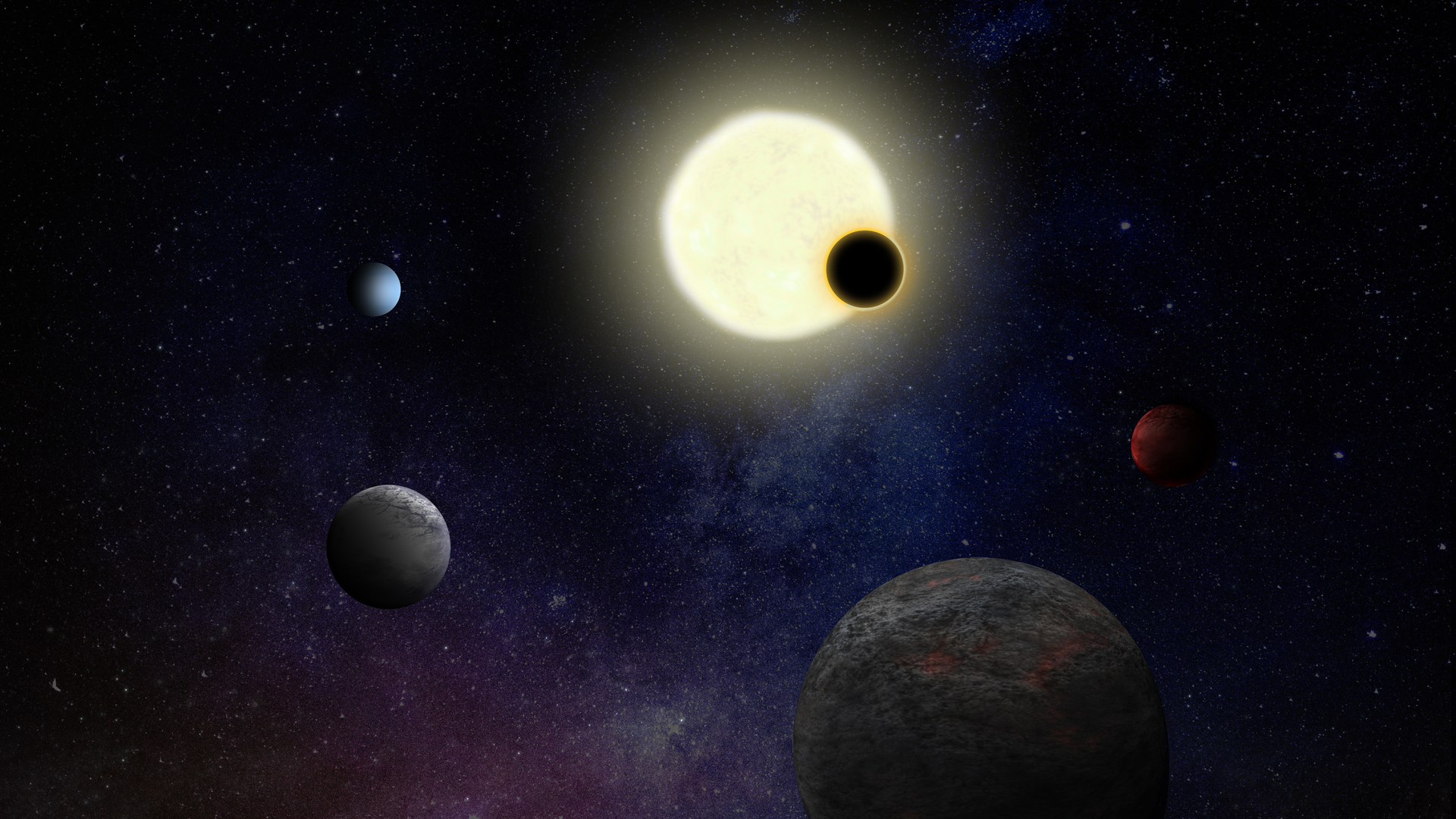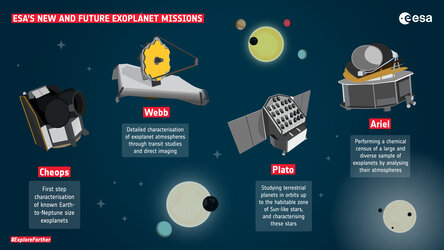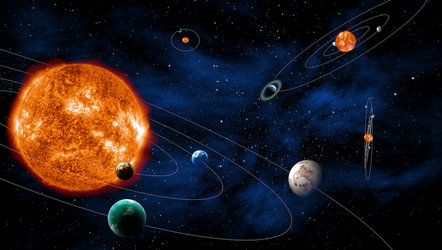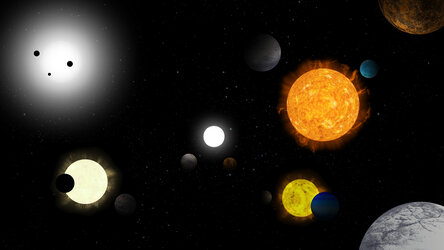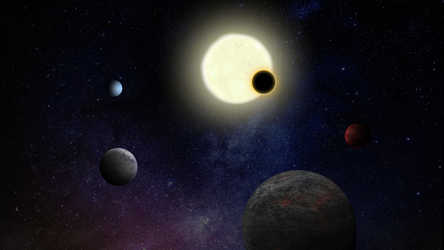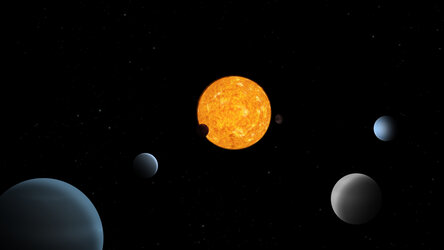What do exoplanets look like?
Imagine a gaseous exoplanet five times the size of Jupiter but much closer to its star as Mercury is to our Sun. This planet orbits its star in just a couple of days and always shows the same face towards it. Now, imagine a tiny rocky planet, only a third of the size of Earth orbiting its star in only 4.5 hours. These kinds of worlds really exist. Exoplanets vary in size, orbit, composition and more. But how can we know all these aspects?
Different characterisation techniques have been developed and are adopted by ESA’s exoplanet missions. In this endeavor, thousands of exoplanets will be subject to a study of mass, size, density, composition and age. Below you can find explanations of the various characterisation techniques.
Size – transit method

The transit method provides a way to learn about exoplanets. When a planet passes in front of their star (from the point of view of the observer), it causes some of the starlight to be blocked. The observer temporarily receives less light from the star. ESA’s mission Cheops will look at planets known to transit and decipher their size. Plato will look for new, unknown exoplanets using the transit method. The bigger the planet, the deeper the dip in star brightness it causes. Cheops focuses on planets with sizes between that of Earth and Neptune and shorter orbital periods (<50 days). The orbital period is the time it takes for a planet to complete one orbit around their host star. For transiting exoplanets, this orbital period is easy to determine as it is just the time between two consecutive dips in light. Plato will be able to observe Earth-sized planets with longer orbital periods (>90 days).
Mass – radial velocity and transit time variations

The mass is a fundamental characteristic of an exoplanet. Scientists can learn a lot about how planets form around their stars by comparing how massive different exoplanets are. Two methods can provide us with information on the mass of exoplanets. One is the radial velocity method, used by several ground-based observatories. When a star has a planet, the system moves around a common point, called the mass centre. During this orbit, the stars’ light appears bluer when it moves towards the observer and redder when it moves away. This shift in frequency is known as the Doppler effect, the same effect as the change in pitch of an ambulance siren as it rushes past you. By measuring the shift in light coming from the star, it is possible to determine the velocity – the speed and direction – by which the star moves around the centre of mass. The velocity is directly correlated with the mass of the planet.

Another method that provides us with information on the mass of exoplanets is that of Transit Time Variations or TTV for short. This method works like the transit method for a planetary system with multiple planets. Normally the time between transits of the same planet is not expected to vary. When a planet is seen crossing the face of its star earlier or later than expected, the system likely has another planet gravitationally tugging or pushing on its neighbour. This method has already led to the discovery of more than 40 exoplanets. What is interesting, is that the time difference between the transits also reveals information on the masses of the planets. This technique is used by ESA’s missions Cheops and Plato.
Density – combine two methods
Once both the mass and size are known, the density of the exoplanet can be determined. This is essential information as it can reveal its nature: is the exoplanet rocky like Earth and Mars or of a gaseous nature such as Saturn and Jupiter? Studying the diversity in exoplanets can shine a light on the formation of planetary systems.
Composition of atmosphere – transmission spectroscopy

With spectroscopy we can study what the atmospheres of exoplanets are made of. Spectroscopy is the technique of splitting received starlight into its different colours using a prism. During a transit of a planet some of the starlight passes through the planet’s atmosphere. Particles in the atmosphere like water vapour, carbon dioxide, methane and others absorb some of that light. This absorption happens at specific wavelengths of light. By studying at which wavelengths the starlight is absorbed, we can determine what kind of particles are present in the atmosphere. Tracking changes in the atmosphere over time gives insight in processes occurring on the surface of these exoplanets. The NASA/ESA/CSA James Webb Space Telescope uses this technique to characterise exoplanets and ESA's Ariel mission will study the atmospheres of as many as 1000 exoplanets this way.
Clouds and surface – phase curve

When a planet orbits its star, it reflects starlight just like our Moon does with sunlight. In the same way, exoplanets have different ‘phases’ where different fractions of their surface reflect light. By studying the small differences in received sunlight during the planet’s orbit, it is possible to determine how reflective the planet’s surface is. Interestingly, also the presence of clouds in the exoplanets’ atmosphere can be revealed this way. The missions Cheops and Plato, and also Ariel (in parallel to their transit spectroscopy, see above) will use this technique to reveal the surface colours of exoplanets.
Structure of exoplanetary systems – direct imaging

The above methods gave various characteristics of individual exoplanets. If we want to learn more about exoplanetary systems as a whole, we can make a direct image of the system. Taking a picture of planets is hard because the light of stars outshines that of their planets. You need a very high-resolution camera or a way to block out the bright starlight and not all space missions are equipped for the task. The Hubble and James Webb space telescopes have the needed resolution and have been able to make images of planets around stars other than our Sun. With this technique we can also learn about the planets’ orbital periods and the distances to their stars. The new space telescope Roman will be able to image Jupiter-sized planets on orbits similar to Jupiter around the Sun. The telescope will do this by blocking the light of the star and image the fainter light of the planets around it.















 Germany
Germany
 Austria
Austria
 Belgium
Belgium
 Denmark
Denmark
 Spain
Spain
 Estonia
Estonia
 Finland
Finland
 France
France
 Greece
Greece
 Hungary
Hungary
 Ireland
Ireland
 Italy
Italy
 Luxembourg
Luxembourg
 Norway
Norway
 The Netherlands
The Netherlands
 Poland
Poland
 Portugal
Portugal
 Czechia
Czechia
 Romania
Romania
 United Kingdom
United Kingdom
 Slovenia
Slovenia
 Sweden
Sweden
 Switzerland
Switzerland

























